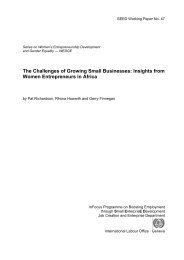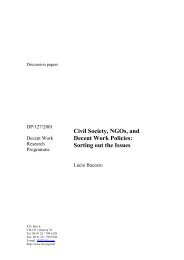Social and Solidarity Economy: Our common road towards Decent ...
Social and Solidarity Economy: Our common road towards Decent ...
Social and Solidarity Economy: Our common road towards Decent ...
You also want an ePaper? Increase the reach of your titles
YUMPU automatically turns print PDFs into web optimized ePapers that Google loves.
SOCIAL AND SOLIDARITY ECONOMY ACADEMY<br />
Box 1.1: The International<br />
Cooperative Alliance<br />
The International Cooperative Alliance was<br />
founded in London in 1895. It currently has 223<br />
members that operate in all sectors of activity,<br />
particularly in agriculture, insurance, banking,<br />
consumers, housing, industry, fisheries, health<br />
<strong>and</strong> tourism, with a total membership of some<br />
800 million people throughout the world. The<br />
Mondragón Corporation in the Spanish Basque<br />
region is a well-known example of a<br />
territory-embedded enterprise. In the 1950s, the<br />
local population started work on a truly<br />
industrial complex in order to rebuild the<br />
regional economy which had been destroyed by<br />
the Civil War <strong>and</strong> the Second World War.<br />
Mondragón has now become an International<br />
Cooperative Group employing more than 92,000<br />
people, mostly in industry <strong>and</strong> retail sectors<br />
(Mondragon CC, 2010). In the United Kingdom,<br />
the cooperative group includes about 75,000<br />
employees <strong>and</strong> spends many resources on<br />
supporting new cooperatives <strong>and</strong> community<br />
initiatives.<br />
In recognition of the potential of cooperatives to<br />
prevent <strong>and</strong> reduce poverty <strong>and</strong> to provide<br />
employment opportunities, the General Assembly of<br />
the United Nations has declared that 2012 will be the<br />
International Year of the Cooperatives in order to<br />
“encourage all Member States, as well as the United<br />
Nations <strong>and</strong> all other relevant stakeholders, to take<br />
advantage of the International Year of Cooperatives<br />
as a way of promoting cooperatives <strong>and</strong> raising<br />
awareness of their contribution to social <strong>and</strong><br />
economic development” (UN Resolution<br />
A/RES/64/136, Operational Paragraph 3).<br />
1.2.2 Mutual benefit societies<br />
Organizations for mutual aid have existed for a very<br />
long time just about everywhere. Mutual benefit<br />
societies are organizations whose objective is<br />
essentially to provide social services for their<br />
individual members <strong>and</strong> their dependants. These<br />
societies – whether formal or informal – meet the<br />
need of communities to organize collective social<br />
relief themselves by sharing a wide variety of risks:<br />
health care, medicines, illness (such as from<br />
sickness or accidents), material support for<br />
bereaved families, repatriation of a body,<br />
expenditures incurred in rituals (such as burial<br />
societies), poor harvests, poor fishing seasons, etc.<br />
Mutual benefit societies provide services through a<br />
mechanism where risks are shared <strong>and</strong> resources<br />
are pooled. The main differences between these <strong>and</strong><br />
classical insurance companies is that mutual benefit<br />
societies are not-for-profit <strong>and</strong> they do not select<br />
their members nor calculate members’ premiums on<br />
the basis of their individual risks.<br />
Many mutual benefit structures operate in the social<br />
protection sector. The Association Internationale de<br />
la Mutualité (AIM) was established in the 1950s. It<br />
unites 40 federations or associations of autonomous<br />
mutual benefit societies in health <strong>and</strong> social<br />
protection in 26 countries across the world. The AIM<br />
affiliates operate according to the principles of<br />
solidarity <strong>and</strong> non-profit, providing coverage for<br />
more than 170 million people throughout the world.<br />
In the insurance sector, the International<br />
Cooperatives <strong>and</strong> Mutual Insurance Federation<br />
(ICMIF) represents the interests of both cooperatives<br />
<strong>and</strong> mutual benefit organizations. The ICMIF has a<br />
current membership of 212 affiliates in 73 countries.<br />
Some labour force rotation schemes or informal<br />
rotating savings <strong>and</strong> credit associations (also known<br />
as tontines in some parts of the world) can be<br />
associated with the mutual <strong>and</strong> benefit societies in<br />
the sense that they combine societal development<br />
<strong>and</strong> social interaction with economic or financial<br />
functions (labour force or savings <strong>and</strong> credit), where<br />
the participants decide on the conditions <strong>and</strong> rules.<br />
The service provided is part of a social relationship<br />
which creates <strong>and</strong> resolves reciprocal obligations<br />
<strong>and</strong> shared interests (Servet, 2006).<br />
1.2.3 Associations <strong>and</strong> community-based<br />
organizations<br />
Freedom of association is a recognized human right,<br />
but its practice depends on how it is safeguarded in<br />
national jurisdictions <strong>and</strong> on the acceptance <strong>and</strong><br />
support of such undertakings. In practice, the SSE<br />
may be seen as a framework to realize different<br />
2<br />
READER

















